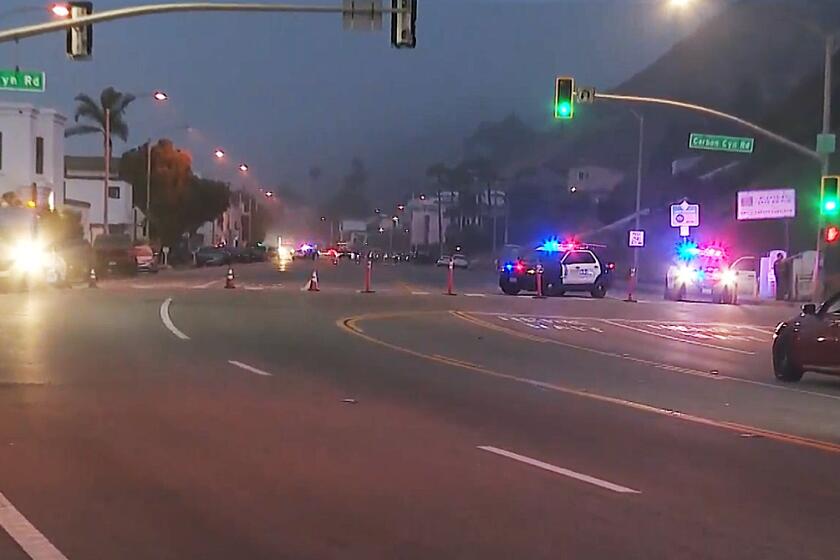U.S. Opens a High-Rise Prison in Civic Center
Rising 10 stories next to the Hollywood Freeway, the sleek, stucco-and-glass building looks more like a backdrop for television’s “L.A. Law” than a prison designed to house some of the most notorious criminal suspects in Southern California.
Kevin Mitnick, the 25-year-old computer genius accused of breaking into university and corporate computers from Los Angeles to Leeds, England, now calls it home.
So does Barry Minkow, the one-time millionaire whiz kid awaiting sentencing on 57 counts of fraud stemming from the collapse of his ZZZZ Best Carpet Cleaning Co.
So does Marvin McCaleb, the accused Baldwin Hills drug czar suspected of acting as supplier for a cocaine organization that had distribution links throughout Los Angeles, Detroit, Oakland, St. Louis and Kansas City.
Variety of Crimes
And so do about 340 other men facing charges of narcotics trafficking, bank robbery, stock swindling and various other crimes that make their way through the federal court system in Los Angeles.
With the opening in December of the $36-million Metropolitan Detention Center, Los Angeles became the fifth major urban area in the country to have a downtown federal prison--and the first in the nation to adopt a prison-wide no-smoking policy.
The high-tech, 272,000-square-foot facility, with its balconies, sunny atrium and expansive plate-glass windows, does have more the look of a downtown office building than a prison. The cells are not cells, they are “rooms,” complete with bunk beds and wooden doors; the common areas are equipped with microwave ovens and hot lines to the public defender’s office; there is not an iron bar in sight.
All Levels of Inmates
But federal Bureau of Prison officials say the Metropolitan Detention Center will for the first time provide Southern California with a secure federal prison facility designed for all levels of inmates, from the fellow indicted a few months ago for beating up his mailman to a Mafia boss.
Until now, federal prisoners awaiting trial and sentencing were kept 25 miles south of the Civic Center at Terminal Island, which was designed to house only medium-security prisoners who had already been sentenced. The Terminal Island prison has been plagued in recent months with a rash of escapes and attempted escapes among the higher-security inmates it was forced to accommodate.
The new detention center at 535 N. Alameda St. will allow prisoners whose trials are pending to be housed just two blocks from the U.S. District Courthouse, ending the time-consuming process of transporting them back and forth down the Harbor Freeway each day court is in session.
“There’s just so many aspects to having this facility open. It really is like having a grand Christmas present, a blessing from heaven,” Chief Deputy U.S. Marshal David Stanton said.
The U.S. Marshal’s Service estimates that it will save at least $200,000 a year by not having to transport the usual 250 to 300 prisoners a week from Terminal Island. The federal public defender’s office figures it will save $18,000 a year in telephone bills alone, because it will no longer have to rely on clients calling person-to-person collect from Terminal Island.
Terminal Island, which has been filled to nearly double its capacity since it began housing pretrial and convicted but not-yet-sentenced prisoners in 1981, will be able to lower its total inmate levels somewhat and house more prisoners of the kind it was designed for: medium-security inmates serving out their sentences.
“What this means is, we will be able to return to really what the institution is designed for,” said Jim Zangs, executive assistant to the warden.
The Metropolitan Detention Center debut has not gone without a hitch. In the days immediately after its Dec. 14 opening, defense attorneys complained about having to wait hours at a stretch to visit clients.
“Right before it opened, we were all going around saying how wonderful it was going to be having the MDC (Metropolitan Detention Center) right over here,” said Yolanda M. Barrera, chief deputy federal public defender.
“But we have had problems since it opened with regards to the waiting. Last week, I waited 2 1/2 hours and still didn’t see anyone, and finally gave up and left,” Barrera said.
“But they are problems that any institution is going to have in the initial stages of operation.”
More controversial has been the center’s no-smoking policy, the first total smoking ban for inmates and staff adopted at any federal prison in the country.
In the facility’s first few weeks, one inmate reportedly tore up his cell and two others were involved in protests that some prison officials attribute at least partly to frustration over the smoking ban.
One inmate who had been smoking four or five packs a day obtained a court order to return to Terminal Island. Another initially asked for a court order but then decided to stay at the center “because the food’s really good,” Barrera said.
“One or two had been smoking their whole lives. It was like the last pleasure they had. And to take that away meant they had nothing left,” Deputy Federal Public Defender Kerry Bensinger said.
But some inmates, he added, have said they look forward to breaking the smoking habit.
Warden Margaret Hambrick said she decided on the no-smoking policy because of the high-rise design and closed-climate air recirculation system that could expose nonsmokers to secondary smoke. Two state prisons in Washington and Utah have adopted similar policies, she said.
“I’m concerned about side-stream smoke and its effect on nonsmokers, and the long-term health effects that smokers suffer are also very clear in the research,” she said.
Destructive Protests
In response to the destructive protests, prison officials have decided not to accept any additional high-security inmates for a short time until facilities can be redesigned to accommodate them, she said.
“There are ways to secure rooms where there is very little opportunity for destruction, and we’re just not equipped for that right now,” she said. “We’re new, the staff is new, the inmates are new, they’re all readjusting to a different structure.”
Center officials expect to reach a population of about 500 prisoners over the next few months, still substantially short of its full operating capacity of 1,069.
Within the next few years, the area surrounding the detention center will be expanded to include a new 21-story federal office building and a six-story Veterans Administration outpatient clinic. Construction of those facilities is already under way.
More to Read
Start your day right
Sign up for Essential California for news, features and recommendations from the L.A. Times and beyond in your inbox six days a week.
You may occasionally receive promotional content from the Los Angeles Times.






